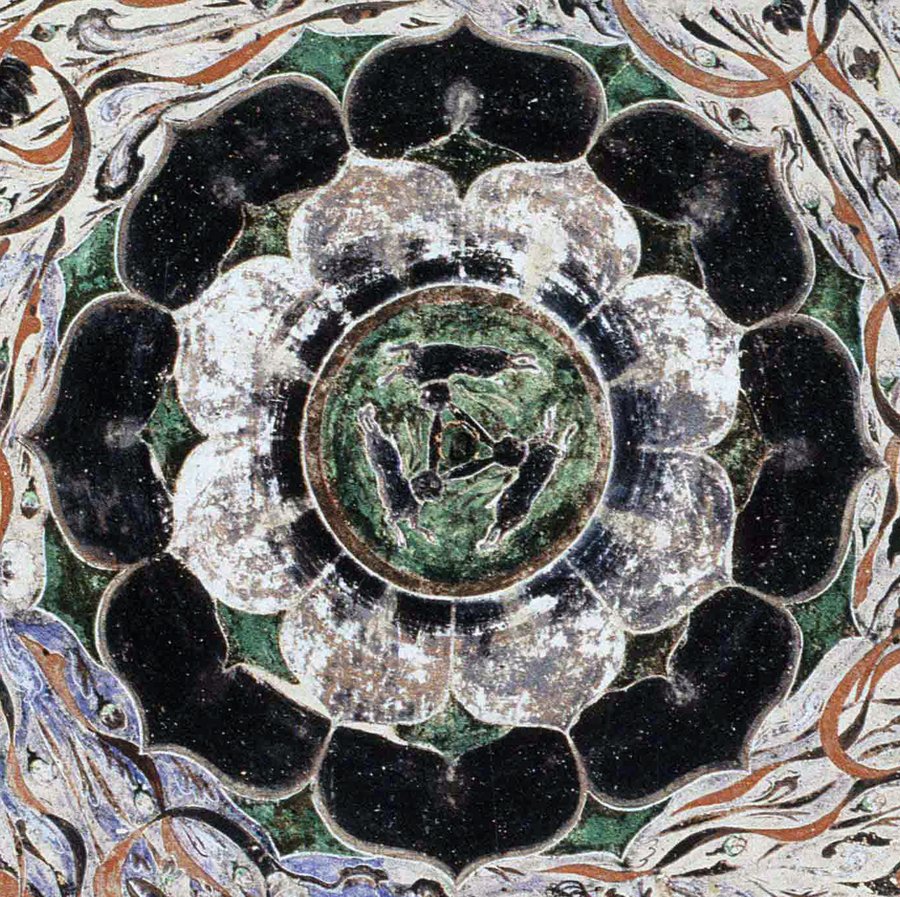Xinhua | January 22, 2023
The picture shows a pattern of the three-rabbit symbol in Cave 407 of Mogao Grottoes, Dunhuang of Gansu Province, China. (Dunhuang Academy/Handout via Xinhua)
As Chinese Lunar New Year, or the Year of the Rabbit, falls on Sunday, the images of rabbits were shown across the world and loved by people both in the East and West.
A rare image of three-rabbits, with each pair of adjacent rabbits sharing an ear and together forming three ears instead of six, and chasing with each other in a circle, were found in both China and other countries, historians said in recent interviews with Xinhua, adding that such an image were deemed as a symbol of cultural exchanges between China and other civilizations via the ancient Silk Road.
CHINA'S THREE-RABBIT IMAGE IN DUNHUANG
The images of three-rabbits, which appeared as early as the sixth century, were found in a total of 20 grottoes in Mogao Grottoes, a UNESCO World Heritage Site, in the Dunhuang city of China's northwestern Gansu Province, said Zhao Yanlin, a researcher with Dunhuang Academy.
They were later shown in the Middle Asia and West Asia between the 12th century and 13th century via Silk Road, and were found in Egypt and Europe between 13th century and 16th century, he said.
The images were also found in many ancient plates in Afghanistan, pottery in Egypt, church clocks in Germany and painted ceramic tiles in Britain, he added.
THREE-RABBIT IMAGE IN IRAN
The circular motif is very well known and appears on paintings and pictures either carved on coins, trays and metal objects or painted on clay dishes and tiles. It has been found in many parts of the world, including East Asia and the Middle East. In Iran, a tray of the Middle Ages was found with such symbol.
Kourosh Salehi, an Iranian historian and international affairs expert at the International University of Islamic Denominations, believes that the three-rabbit motif found on different artifacts in Iran reflects China's cultural impact on Iran.
Kourosh Salehi, a historian and international affairs expert at the International University of Islamic Denominations, observes a coin with the rabbit symbol in Tehran, Iran, Jan. 17, 2023. (Xinhua/Gao Wencheng)
The historian said that the three-rabbit symbol found in Iran, as reflected on some metal artifacts and coins, was believed to be brought to Iran by Chinese artists and painters as it perfectly conforms to the ones seen on samples discovered in China in the ancient era, showing the Chinese cultural impact on Iranian culture during the Ilkhanate dynasty (1256-1353).
Among the distinctive features of the three-rabbit symbols in all the artifacts found in Iran so far is that the rabbits are pictured at the center of a round object chasing each other in a circle, which probably implies the continuation of the circle of life, fertility and death.
The ancient Silk Road led to cultural exchanges between China and Iran, leaving visible marks on today's Iranian cultural tradition, one of which being the 12-animal Zodiac, an Iranian historian said.
"Like in China, the upcoming new year in Iran, which will begin on March 22, is also the Year of the Rabbit," said Salehi. "What's interesting is that throughout the evolution process and history, the animals' concept has entered Iran's culture from China and East Asia."
"Iranians, in addition to naming and enumerating the years based on their ordinal numbers according to the Solar Hijri calendar, still say what animal each year represents." From the point of view of semiotics and mythology, Salehi said the rabbit symbolizes fertility, instability, swiftness, cleverness and social life.
A coin with the rabbit symbol is pictured in Tehran, Iran, Jan. 17, 2023. (Xinhua/Gao Wencheng)




